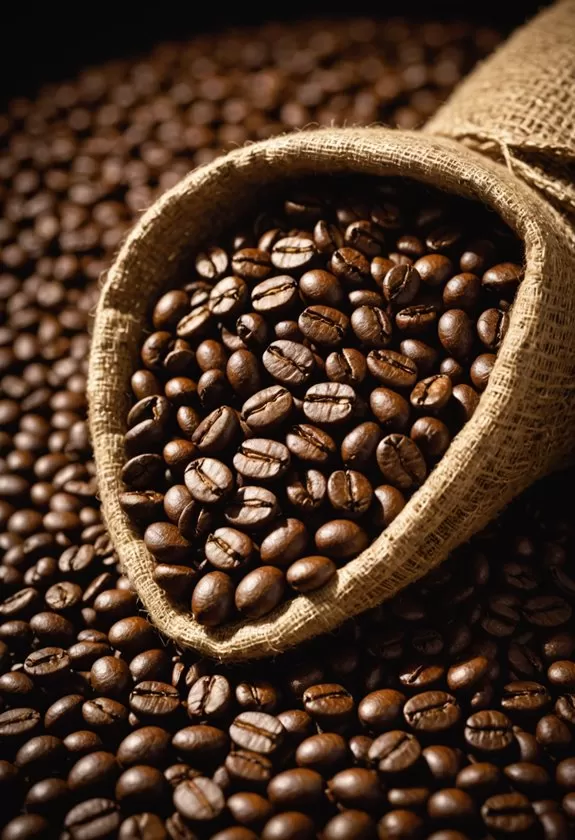Does Old Coffee Beans Have Less Caffeine?
Let's investigate if old coffee beans have less caffeine. You'll be intrigued to learn that caffeine remains a stable compound, so those aged beans in your pantry haven't lost their kick. While flavor and aroma might fade over time, caffeine content stays; it doesn't degrade like other components. This stability means even old coffee beans can deliver a mighty caffeine enhancement. Proper storage helps maintain freshness, but the caffeine's not going anywhere. Brewing might affect extraction levels, yet bean age doesn't impact caffeine. Understanding these details strengthens your choices as you uncover more about coffee's fascinating expedition.
Key Takeaways
- Old coffee beans retain their caffeine content despite losing flavor and aroma.
- The caffeine levels in aged coffee beans remain stable over time.
- Proper storage ensures that caffeine content is preserved in old coffee beans.
- Myths about caffeine loss in old beans are inaccurate; caffeine potency is maintained.
- Old coffee beans can still provide a strong caffeine boost.
Understanding Caffeine Stability

When it comes to understanding caffeine stability, you might be surprised to learn that caffeine is remarkably resilient. As a stable chemical, caffeine maintains its potency over time, even in old coffee beans. Unlike other components that degrade, caffeine levels remain nearly unchanged, guaranteeing that aged beans still pack their caffeine punch. The roasting process has minimal impact on caffeine content, despite common misconceptions about dark vs light roasts.
Caffeine in Old Coffee
While the flavor and aroma of old coffee may fade, the caffeine content doesn't experience the same degradation. This means you can still get the caffeine lift you're looking for, even if the taste isn't as fresh. The resilience of caffeine guarantees that the stimulant effect is preserved, regardless of the beans' age.
Storage and Preservation
Proper storage conditions play an essential role in maintaining caffeine stability. Storing coffee beans in a cool, dry place shields them from moisture and air, which can accelerate quality degradation.
Whole coffee beans are particularly good at retaining caffeine, unlike ground coffee, which loses caffeine more rapidly.
Let's investigate this further: by understanding how caffeine remains stable, you can better appreciate why old coffee still provides the desired effects. This knowledge helps you make informed choices about your coffee consumption, even if your beans are past their prime.
Effects of Coffee Bean Age
As coffee beans age, you'll notice changes primarily in their flavor and aroma, not their caffeine content. Old coffee beans retain their caffeine well because caffeine is a stable compound.
So, even if the beans lose some of their flavor due to oxidation, the caffeine content stays almost the same as when the beans were fresh. This means that your cup of coffee can still give you a good caffeine kick, even if it doesn't taste as lively.
The Role of the Roasting Process
The roasting process impacts how you perceive caffeine strength. Fresh coffee often seems stronger in flavor, but that doesn't mean it has more caffeine than old coffee beans.
The roasting process can create complex flavors, but it doesn't greatly affect caffeine levels. So, whether the beans are freshly roasted or aged, they'll typically have similar caffeine content.
Ground Coffee Considerations
However, ground coffee loses caffeine more rapidly than whole beans. If you grind your coffee and let it sit, it may lose more caffeine over time compared to whole beans.
While the flavor degradation might be noticeable, the caffeine in the old coffee beans remains relatively potent, ensuring your coffee still provides a stimulating effect. For the best flavor preservation, store your beans in an airtight container away from light and heat.
Storage Tips for Freshness

To keep your coffee beans fresh and preserve their caffeine content, consider storing them in airtight containers. Proper storage can greatly slow down the degradation of coffee quality.
Let's investigate ideal storage conditions to guarantee your coffee remains flavorful and potent.
Choosing the Right Container
Use airtight containers to prevent air exposure, which can lead to staleness. Opaque containers block light, reducing photodegradation.
Vacuum-sealed bags are great for long-term storage, particularly for both green coffee and roasted coffee beans, helping maintain quality.
Ideal Environment
Store your coffee in a cool, dark, and dry place. Avoid areas with direct sunlight, heat, and moisture, as these elements degrade coffee quality and caffeine content.
Keeping coffee beans away from these conditions preserves their flavor and aroma.
Timing and Use
After opening, use coffee beans within two weeks for ideal freshness. Prolonged air exposure can cause flavor loss.
When grinding coffee, only grind the amount you need. Grinding increases surface area, leading to faster caffeine loss.
Fresh bean portioning is essential as grinding just before brewing ensures maximum flavor retention.
Brewing Methods and Caffeine
Although you might think all brewing methods are created equal, they each have a distinct impact on caffeine extraction.
Let's examine how different techniques can influence your brewed coffee's caffeine content. Espresso, for instance, packs a punch with higher caffeine concentrations per ounce due to its quick extraction process. On the other hand, cold brew coffee takes its time, using a longer steeping duration that results in more caffeine extraction compared to traditional brewed coffee.
The roast level also plays a role in caffeine extraction. Light roast coffee, with its lighter color and flavor, can achieve up to 92% extraction efficiency. In contrast, dark roast beans reach up to 95% efficiency, often resulting in slightly different caffeine levels.
The roast date matters too; fresher beans might offer better flavors but won't necessarily change caffeine content dramatically.
Water temperature is another significant factor. Hotter water extracts caffeine more effectively, increasing the caffeine content in your cup.
Additionally, grind size affects extraction; finer grinds enhance the surface area, leading to faster caffeine release.
Using a stainless steel grinder ensures consistent grind size and optimal caffeine extraction from your beans.
Myths About Caffeine Loss

Understanding caffeine stability in aged coffee can help you make smarter choices about using old coffee.
Instead of tossing those old beans, remember they still offer the caffeine kick you need, just with a slightly muted taste.
Let's investigate how knowing these facts can prevent unnecessary waste and keep you caffeinated with confidence.
Now, you can enjoy a reliable caffeine enhancement without worrying about myths that suggest otherwise.
Conclusion
You've learned that old coffee beans don't lose much caffeine over time, but their flavor can degrade. To keep your coffee fresh, store beans in airtight containers, away from light and heat. Brewing methods, like espresso or French press, can affect caffeine levels, so choose what suits your taste. Don't fall for myths—caffeine stability is reliable. With this knowledge, you can enjoy a consistently invigorating cup of coffee every time you brew.







